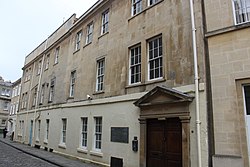Old Orchard Street Theatre
| Old Orchard Street Theatre | |
|---|---|
 |
|
| Location | Bath, Somerset, England |
| Coordinates | 51°22′49″N 2°21′29″W / 51.38028°N 2.35806°WCoordinates: 51°22′49″N 2°21′29″W / 51.38028°N 2.35806°W |
| Built | 1747-1750 |
| Architect | Hippesley and Watts |
|
Listed Building – Grade II
|
|
| Official name: Masonic Hall formerly Theatre | |
| Designated | 12 June 1950 |
| Reference no. | 443204 |
The Old Orchard Street Theatre in Bath, Somerset, England was built as a provincial theatre before becoming a Roman Catholic Church and since 1865 has been a Masonic Hall. It is a Grade II listed building.
In 1705 the first theatre opened in Bath. It was on a site which The building by George Trim was small and cramped and made little profit in the years before its demolition in 1738. The site it was on is now the Royal National Hospital for Rheumatic Diseases. A New Theatre opened in Kingsmead Street in 1723 and operated until 1751.
In 1747 John Hippisley proposed the construction of a new theatre and a revised version in 1748 just before his death. The planning was taken over by John Palmer, a local brewer and chandler. The site for a new theatre was chosen by John Wood, the Elder, who laid out much of the city, on the site of the old orchard of Bath Abbey. Construction work for the theatre in Old Orchard Street began in 1748, to designs by the architect Thomas Jolly of Hippesley and Watts, with the work being completed by John Powell in 1750. The theatre was 60 feet (18 m) long and 40 feet (12 m) board. The theatre, known as The St James Theatre, opened on 27 October, under the management of John Palmer, with a performance of William Shakespeare’s Henry IV, Part 2.
Palmer obtained a royal patent in 1768 which enabled the use of the title ‘Theatre Royal’; the first to achieve this outside London. He handed control to his son, also John Palmer who worked as his father's London agent, frequently travelling between London and Bath. Palmer also owned the Theatre Royal, King Street, in Bristol, which now houses the Bristol Old Vic. The two theatres shared one acting company, so Palmer had to move his actors, stagehands and props quickly between Bristol and Bath, he set up a coach service which provided safe, quick and efficient transport for his actors and materials. Later, when Palmer became involved in the Post Office, he believed that the coach service he had previously run between theatres could be utilised for a countrywide mail delivery service. He continued to manage the theatre until 1785 when he was appointed as Comptroller-General of the Post Office, and handed control to two existing members of the company, William Keasberry and William Wyatt Dimond. Keasberry (1726–1797) was associated with the theatre as actor and manager from 1757 to 1795, first acting as manager during the season of 1760.
...
Wikipedia

